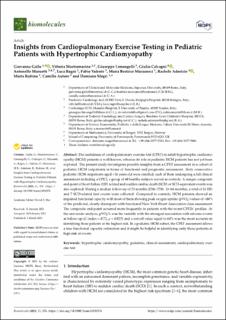| dc.contributor.author | Gallo, Giovanna | |
| dc.contributor.author | Mastromarino, Vittoria | |
| dc.contributor.author | Limongelli, Giuseppe | |
| dc.contributor.author | Calcagni, Giulio | |
| dc.contributor.author | Maruotti, Antonello | |
| dc.contributor.author | Ragni, Luca | |
| dc.contributor.author | Valente, Fabio | |
| dc.contributor.author | Musumeci, Beatrice | |
| dc.contributor.author | Adorisio, Rachele | |
| dc.contributor.author | Rubino, Marta | |
| dc.contributor.author | Autore, Camillo | |
| dc.contributor.author | Magrì, Damiano | |
| dc.date.accessioned | 2022-04-25T09:20:11Z | |
| dc.date.available | 2022-04-25T09:20:11Z | |
| dc.date.created | 2022-01-19T11:13:44Z | |
| dc.date.issued | 2021 | |
| dc.identifier.issn | 2218-273X | |
| dc.identifier.uri | https://hdl.handle.net/11250/2992450 | |
| dc.description.abstract | The usefulness of cardiopulmonary exercise test (CPET) in adult hypertrophic cardiomyopathy (HCM) patients is well-known, whereas its role in pediatric HCM patients has not yet been explored. The present study investigates possible insights from a CPET assessment in a cohort of pediatric HCM outpatients in terms of functional and prognostic assessment. Sixty consecutive pediatric HCM outpatients aged <18 years old were enrolled, each of them undergoing a full clinical assessment including a CPET; a group of 60 healthy subjects served as controls. A unique composite end-point of heart failure (HF) related and sudden cardiac death (SCD) or SCD-equivalent events was also explored. During a median follow-up of 53 months (25th–75th: 13–84 months), a total of 13 HF- and 7 SCD-related first events were collected. Compared to controls, HCM patients showed an impaired functional capacity with most of them showing peak oxygen uptake (pVO2) values of <80% of the predicted, clearly discrepant with functional New York Heart Association class assessment. The composite end-point occurred more frequently in patients with the worst CPETs’ profiles. At the univariate analysis, pVO2% was the variable with the strongest association with adverse events at follow-up (C-index = 0.72, p = 0.025) and a cut-off value equal to 60% was the most accurate in identifying those patients at the highest risk. In a pediatric HCM subset, the CPET assessment allows a true functional capacity estimation and it might be helpful in identifying early those patients at high risk of events. | en_US |
| dc.language.iso | eng | en_US |
| dc.publisher | MDPI | en_US |
| dc.rights | Navngivelse 4.0 Internasjonal | * |
| dc.rights.uri | http://creativecommons.org/licenses/by/4.0/deed.no | * |
| dc.title | Insights from cardiopulmonary exercise testing in pediatric patients with hypertrophic cardiomyopathy | en_US |
| dc.type | Journal article | en_US |
| dc.type | Peer reviewed | en_US |
| dc.description.version | publishedVersion | en_US |
| dc.rights.holder | Copyright 2021 by the authors | en_US |
| dc.source.articlenumber | 376 | en_US |
| cristin.ispublished | true | |
| cristin.fulltext | original | |
| cristin.qualitycode | 1 | |
| dc.identifier.doi | 10.3390/biom11030376 | |
| dc.identifier.cristin | 1984487 | |
| dc.source.journal | Biomolecules | en_US |
| dc.identifier.citation | Biomolecules. 2021, 11 (3), 376. | en_US |
| dc.source.volume | 11 | en_US |
| dc.source.issue | 3 | en_US |

